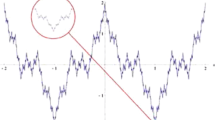Abstract
A random telegraph signal is a time series whose value S(t) at time t is either one of only two possible values. Many processes including chemical reactions, cell membrane ion channels, and electronic noise generate such signals. Usually, Markov models have been used to model and analyze such data. Instead, we present a new fractal random telegraph signal that is statistically self-similar in time. We show how to analyze such signals and apply those techniques to study burst noise in a defective operational amplifier and ion currents recorded through individual ion channels in a cell membrane.
Similar content being viewed by others
Abbreviations
- A :
-
proportionality constant in the power lawk=At 1−D
- A c :
-
proportionality constant for entering the closed state
- A o :
-
proportionality constant for entering the open state
- c (subscript):
-
closed level of the two state (open-closed) signal
- D :
-
fractal dimension
- D c :
-
fractal dimension associated with entering the closed state
- D o :
-
fractal dimension associated with entering the open state
- f(t) :
-
probability density of the durationst in a state
- k :
-
transition rate (probability per unit time) of exiting a state
- k eff :
-
effective transition rate measured at time scalet eff
- k c(eff) :
-
effective transition rate for entering the closed state
- k o(eff) :
-
effective transition rate for entering the open state
- o (subscript):
-
open level of the two state (open-closed) signal
- P(t) :
-
cumulative probability distribution of the durationst in a state
- S(t) :
-
signal level at timet
- t :
-
time
- t eff :
-
effective time scale at which a measurement is done
- X(t) :
-
state at timet
References
Bergquist, J.C.; Hulet, R.G.; Itano, W.M.; Wineland, D.J. Observation of quantum jumps in a single atom. Phys. Rev. Lettr. 57:1699–1702; 1986.
Blatz, A.L.; Magleby, K.L. Correcting single channel data for missed events. Biophys. J. 49:967–980; 1986.
Brown, S.R.; Scholz, C.H. Broadband study of the topography of natural rock surfaces. J. Geophys. Res. 90:12575–12582; 1985.
Card, W.H.; Chaudhari, P.K. Characteristics of burst noise. Proc. IEEE 53:652–653; 1965.
Cox, D.R. Renewal Theory. London; Science Paperbacks; 1962.
Dewdney, A.K. Of fractal mountains, graftal plants and other computer graphics at Pixar. Sci. Amer. 1986 Dec. pp. 14–20.
Eykholt, R.; Umberger, D.K. Characterization of fat fractals in nonlinear dynamical systems. Phys. Rev. Lettr. 57:2333–2336; 1986.
Hille, B. Ionic Channels of Excitable Membranes. Sunderland, MA: Sinauer; 1984.
Howard, R.E.; Jackel, L.D.; Mankiewich, P.M.; Skocpol, W.J. Electrons in silicon microstructures. Science 231:346–349; 1987.
Hsu, S.T.; Whittier, R.J.; Mead, C.A. Physical model for burst noise in semiconductor devices. Solid State Electron. 13:1055–1071; 1970.
Itano, W.M.; Bergquist, J.C.; Wineland, D.J. Laser spectroscopy of trapped atomic ions. Science 237:612–617; 1987.
Koniarek, J.P.; Markowitz, G.D.; Liebovitch, L.S.; Fischbarg, J. Single channel recordings from rabbit corneal endothelium in vitro.Biophys. J. 49:365a; 1986.
Liebovitch, L.S.; Buisman, H.P. Single channel-like electronic artifact recorded from patch clamp amplifiers. Biophys. J. 53:265a; 1988.
Liebovitch, L.S.; Fischbarg, J.; Koniarek, J.P. Optical correlation functions applied to the random telegraph signal: how to analyze patch clamp datawithout measuring the open and closed times. Math. Biosci. 78:203–215; 1986.
Liebovitch, L.S.; Fischbarg, J.; Koniarek, J.P. Ion channel kinetics: a model based on fractal scaling rather than multistate Markov processes. Math. Biosci. 84:37–68; 1987.
Liebovitch, L.S.; Fischbarg, J.; Koniarek, J.P.; Todorova, I.; Wang M. Fractal model of ion-channel kinetics. Biochim. Biophys. Acta 896:173–180; 1987.
Liebovitch, L.S.; Sullivan, J.M. Fractal analysis of a voltage dependent potassium channel from cultured mouse hippocampal neurons. Biophys. J. 52:979–988; 1987.
Machlup, S. Noise in semiconductors: spectrum of a two parameter random signal. J. Appl. Phys. 25:341–343; 1954.
Mandelbrot, B.B. The Fractal Geometry of Nature. San Francisco: W.H. Freeman; 1983.
Nagourney, W.; Sandberg, J.; Dehmelt, H. Shelved optical electron maplifier: observation of quantum jumps. Phys. Rev. Lettr. 56:2797–2799; 1986.
Papoulis, A. Probability, Random Variables, and Stochastic Processes. New York: McGraw Hill; 1985.
Ralls, K.S.; Skocpol, W.J.; Jackel, L.D.; Howard, R.E.; Fetter, L.A.; Epworth, R.W.; Tennant, D.M. Discrete resistance switching in submicrometer silicon inversion layers: individual interface traps and low-frequency (1/f?) noise. Phys. Rev. Lettr. 52:228–231; 1984.
Rice, S.O. Mathematical analysis of random noise, Wax, N., ed. In: Selected Papers on Noise and Stochastic Processes. New York: Dover; 1954; pp. 176–181.
Sakmann, B.; Neher, E., editors. Single Channel Recording. New York: Plenum; 1983.
Sander, L.M. Fractal growth. Sci. Amer. 1987 Jan., pp. 94–100.
Sauter, T.; Neuhauser, W.; Blatt, R.; Toschek, P.E. Observation of quantum jumps. Phys. Rev. Lettr. 57:1696–1698; 1986.
Shlesinger, M.F. Williams-Watts dielectric relaxation: a fractal time stochastic process. J. Stat. Phys. 36:639–648; 1984.
Stanley, H.E.; Ostrowsky, N., editors. On Growth and Form—Fractal and Non-Fractal Patterns in Physics. Boston: Martinus Nijhoff; 1986.
Stein, W.D. Transport and Diffusion across Cell Membranes. New York: Academic Press; 1986.
Sullivan, J.M. A voltage- and calcium-sensitive inward rectifying potassium channel active in the resting membrane of cultured mouse hippocampal neurons. Biophys. J. 51:54a, 1987.
Williams, G.; Watts, D.C. Non-symmetrical dielectric relaxation behaviour arising from a simple empirical decay function. Trans. Faraday Soc. 66:80–85; 1970.
Youschkevitch, A.A., Markov, Andrei Andreevich. In: Gillispie, C.C., ed. Dictionary of Scientific Biography. New York: Charles Scribner's Sons; 1974, Vol. IX, pp. 124–130.
Author information
Authors and Affiliations
Rights and permissions
About this article
Cite this article
Liebovitch, L.S. The fractal random telegraph signal: Signal analysis and applications. Ann Biomed Eng 16, 483–494 (1988). https://doi.org/10.1007/BF02368011
Received:
Revised:
Issue Date:
DOI: https://doi.org/10.1007/BF02368011




